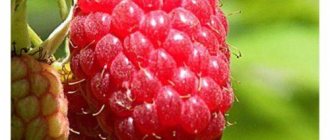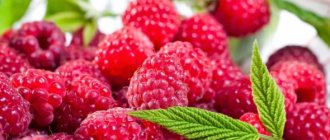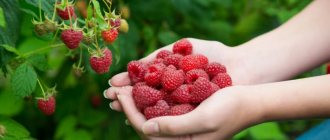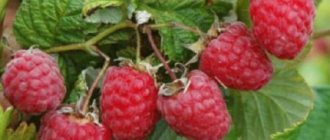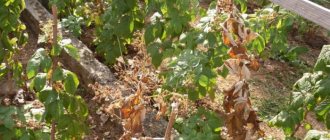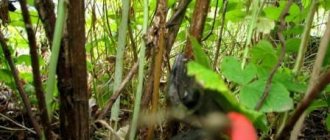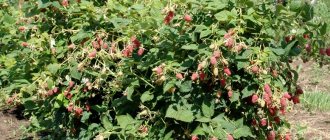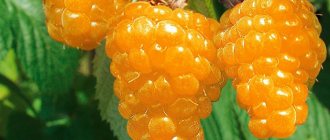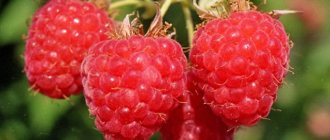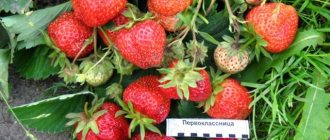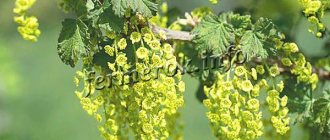The remontant raspberry Inaccessible appeared at the end of the last century. The originator of the variety is breeder from Moscow V.V. Kichina. Raspberries got their name because of the abundant harvest of large, tasty and aromatic berries. With sufficient care, Inaccessible (P-34) can be cultivated in both southern and northern regions, where there are short, cool summers and harsh, long winters.
History of variety selection
The Inaccessible raspberry variety was bred by Moscow breeder Viktor Valeryanovich Kichina in the 80s of the last century. The plant got its name due to its ability to produce a bountiful harvest of fragrant, juicy and large fruits. A harvest unattainable for other berry crops.
Raspberry Unattainable was subjected to testing by biologists and tests conducted by experienced gardeners. After receiving positive results, the variety underwent the official registration procedure in the State Register of the Russian Federation.
Description of the raspberry variety Inaccessible
The appearance of the raspberry called Inaccessible has this description. The plant is a low-growing (up to 1.4 m) and medium-spreading subshrub with a diameter of about 80 cm. But despite its inconspicuous appearance, all shoots are strewn with berries. The berry plant has the following parts:
- Perennial sinuous and woody root system.
- Elastic yellow-brown shoots with shortened internodes, evenly covered with small thorns. Attention! During the growing season, 1 subshrub of the Inaccessible raspberry grows up to 11 offspring.
- The oval leaf blades are dark green above and whitish, slightly pubescent below.
- Small white flowers collected in racemes.
- Shiny red-ruby fruits. Ripe berries are juicy and large, weighing 7–9 g. They have a regular conical shape and a flattened tip. Some specimens grow 3–4 cm long. Their taste is sweet and sour.
With good care, Inaccessible raspberries can be grown both in the southern regions and in the northern ones (where the summer period is short and cold, and the winter period is harsh and long).
Top dressing
Fertilizers must be present in the soil in sufficient quantities. However, this variety is sensitive to their excess.
Therefore, it is necessary to fertilize in the following way:
- First, organic fertilizers are added. This is done immediately after the snow melts and the soil is disinfected.
- During the period of active growth, mineral supplements are added.
- Re-addition of minerals is required during flowering.
- The last time during the season, minerals are added during berry setting.
- Before wintering, 3 weeks before the cold weather, you need to add organic fertilizers again.
Important. When choosing mineral fertilizers, it is necessary to give preference to those based on potassium, phosphorus and superphosphate. In winter, manure is added. It is advisable to apply it in solid form so that the ammonia released from the manure warms the roots in winter. In spring, organic matter should be added in liquid form so that the root system absorbs nutrients faster.
Characteristics of the variety
Berry variety:
- Remontant, that is, fruits appear on both annual and biennial stems.
- Early ripening. From the appearance of flowers to the ripening of fruits, approximately 1–1.5 months pass.
Raspberry Inaccessible is distinguished by a long and undulating fruiting period.
Drought resistance, frost resistance
According to reviews of many gardeners, the Inaccessible raspberry does not tolerate a lack of moisture very well. Dry soil leads to the growth of raspberry bushes stopping, caking and drying of the berries. And the frost resistance of the variety is good.
Warning! Raspberry Inaccessible can withstand winter cold down to -27 ° C if the subshrubs are pruned and well covered.
Productivity and fruiting
Some farmers believe that the variety received its name – Unattainable – due to its rather long fruiting period. It continues until the first frost. And the first harvest can be obtained on the 10th of July.
The berries on the stems appear at the top. The lower fruits ripen much later than the upper ones. Therefore, collection is carried out after 6–7 days. Hardworking gardeners
During the summer season they harvest tasty and aromatic berries about 5 times.
The variety is recognized as high-yielding. From a berry plant you can collect 4.5 kg of fruit. Ripe raspberries may fall off.
Area of application of fruits
Housewives use the fruits:
- Raw. It turns out a delicious treat for children and adults if you add them to sweet sour cream.
- Recycled. The fruits are used to prepare preparations for the winter - compotes, jams and preserves. Moreover, for these delicacies they take one raspberry or add other garden or forest berries to it.
- Store in the freezer.
Fruits are transported only in small plastic containers. Since the berries are quite soft, they quickly wrinkle and lose their presentation.
Comment! Do not forget that even at a temperature of -3–4°C, fruits are not stored for more than 5–6 days.
Resistance to diseases and pests
Experienced gardeners believe that Inaccessible raspberries must be pruned in the fall. Only then will the berry subshrubs not get sick in the next summer season. Not a single pest will encroach on them.
Advantages and disadvantages of the variety
Farmers who cultivate Inaccessible raspberries on their plots highlight the following positive aspects:
- early appearance of berries;
- good and stable yields;
- excellent cold resistance.
Gardeners do not forget to point out the disadvantages of the variety:
- ripe berries are very soft;
- plants require constant irrigation;
- berry culture is capricious.
Without proper ongoing care, Inaccessible raspberries will not bear many berries.
Advantages and disadvantages
The positive qualities of the Inaccessible variety include:
- early fruit ripening;
- stable yield;
- resistance to low temperatures;
- resistance to pests and diseases.
Disadvantages include the crop's capriciousness to growing conditions, its requirement for moisture and insufficient shelf life.
Landing Features
The berry crop is very demanding of its habitat. If you do not take into account all the requirements, then the Inaccessible raspberry will not bear fruit well.
Recommended timing
The berry plant is planted in spring and autumn.
Advice! Experienced gardeners consider the end of the 1st and beginning of the 2nd autumn month to be the best time for planting.
Choosing a suitable location
Raspberry Inaccessible feels good and bears fruit under the following conditions:
- The soil is fertile and well permeable to moisture. Moreover, the soil is dug up in advance with the application of complex fertilizer.
- Groundwater is located far from the surface of the earth.
- The place is well lit and free from drafts. It is better to place the bushes parallel to the fence.
The soil is limed if necessary and must be weeded.
Selection and preparation of planting material
Farmers who have been cultivating Inaccessible raspberries for many years recommend adhering to the following rules when choosing planting material:
- Buy seedlings only from trusted manufacturers - in specialized stores that have been operating for more than one year, or nurseries.
- The gardener must first look at the root system. Seedlings with rotten or dried roots should be immediately discarded. A healthy young plant should have a strong underground part.
- The subshrub should have 2–5 small shoots and roots approximately 10–13 cm long.
Landing algorithm
In the selected area, holes are dug 45 cm wide and 25 cm deep, keeping a distance of 0.9 m between them. The young plant is placed in the hole so that its root collar is above ground level. The hole is filled with black soil, the soil is carefully compacted, watered abundantly and mulch is applied. Then the raspberry bush is trimmed, leaving no more than 30 cm of shoots.
Reviews
Vasilisa: I planted many varieties, but “Unattainable” is the earliest. Grows quickly. There were large raspberries up to 10 g. The main advantage is low and compact bushes. I have been growing it for the fourth year in a row. Even small shoots had small berries. I make jams from it, freeze and dry it. My family are big fans of these raspberries, and my children are delicacies and pick them right from the bushes.
Nargiza: In the spring I decided to plant 4 seedlings. And in the same year it began to bear fruit until October. I noticed a dependence of the variety on weather conditions. In hot weather, the berries are small and fruiting will slow down. It is better to plant them in several bushes, otherwise the neighbor planted a lot and collected them while crawling on her knees. I like it when the fruits ripen at the same time, and therefore, if one bush begins to form another, I cut it out.
Aftercare
Raspberry Unattainable - remontant. This means that the berry plant needs careful care.
- Abundant and constant sprinkling. The procedure is carried out as the soil dries. The soil should be saturated with moisture to a depth of 40 cm. Particular attention should be paid to the degree of soil moisture during the formation of buds and ovaries on plants and the growth of fruits.
- Feeding is required: 2 weeks after planting seedlings in the ground, before flowering, during fruiting.
- Subshrubs are not tied up.
- In case of abundant fruiting, special supports are placed, either ready-made or made independently.
- In late autumn, when the cold weather sets in, pruning is carried out. This procedure requires the gardener to remove all stems.
Important! Stumps should not be left; shoots are cut 2.5–.5 cm below the ground. Cut parts of plants must be burned so that insect pests do not set up rookeries there.
Then the soil is mulched with peat or sawdust, applying a layer of mulch of 14–16 cm.
Features of cultivation and care
Raspberry Inaccessible is able to show its best side only with conscientious and attentive care. She is very partial to fertilizing - even when planting raspberries, it is better to fill the planting holes or trenches with 1.5-2 times more organic matter or mineral fertilizers. We should not forget about fertilizing during the entire growing season. But you shouldn’t be overzealous with nitrogen-containing fertilizers - it’s better to use wood ash, superphosphate, as well as complex fertilizers with a predominant content of potassium and phosphorus and a mandatory set of microelements.
Advice! Raspberry Inaccessible will appreciate a thick layer of organic mulch that will cover the root zone.
You can use a compacted fit. On average, 0.7 to 1.4 meters are left between bushes when planting, depending on the row spacing, which can be from 1.5 to 2 meters.
When pruning in spring, you should leave about 6-7 shoots per bush - this is the optimal amount for obtaining abundant harvests.
At first it seems that due to their compactness and relative short stature, the bushes do not require staking. But it’s better to arrange a single-row trellis in order to improve the illumination of the bushes, organize their maintenance and make harvesting easier.
Regular and abundant watering is necessary throughout the season, especially in areas with hot and dry climates.
Like all remontant raspberries, it is recommended to cut off all shoots at ground level before winter. This will make it possible to get one, but luxurious harvest at a time when traditional raspberries are no longer in sight. If you want to grow Inaccessible raspberries with two harvests per season (summer and autumn), then the overall result will still be less due to the shift in the timing of autumn fruiting into winter.
When planting seedlings in the spring, if they have not yet produced a real harvest, it is recommended to tie them together, bend them down and cover them for the winter.
Attention! When cultivating this raspberry variety in the northern regions, it is advisable to cover the planting site even after pruning the shoots in order to avoid possible freezing of the soil. If frosts are already common in your area in September-October, it is better to throw medium-density spunbond or any other breathable covering material over the raspberry bushes to protect the last berries
If frosts are already common in your area in September-October, it is better to cover the raspberry bushes with medium-density spunbond or any other breathable covering material to protect the last berries.
Reproduction methods
Even an inexperienced gardener can propagate raspberries of the Inaccessible variety on his own. After all, a berry plant produces an increase in root shoots and shoots every year.
- Reproduction by offspring. In the spring, roots with strong shoots are dug up from the mother plant. Then these parts are planted in the chosen place. With this planting in the fall, you can get the first ripe berries.
- Propagation by root cuttings is more labor-intensive than the first method. The thickest root is cut off from the excavated plant. The rhizome is cut into pieces - cuttings. They are planted and watered thoroughly.
In order not to bother with planting suckers and cuttings, you can buy a young plant.
